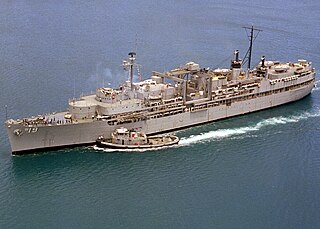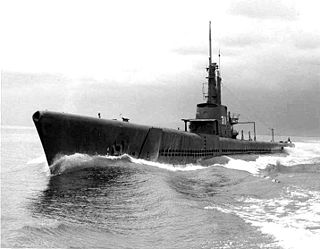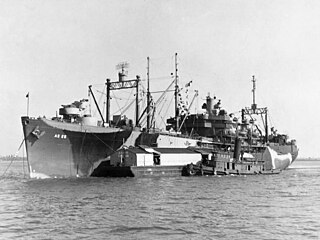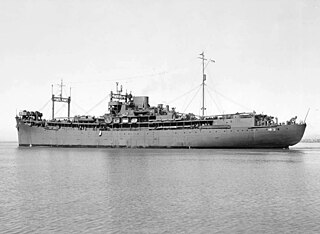Service history
Pacific, 1944–1945
Following her commissioning, the submarine tender got underway for Brooklyn, New York, to load provisions and ammunition at the New York Navy Yard and then traveled to New London, Connecticut, to take on spare parts for submarines and to conduct tests and drills. She departed New London on 11 October and set a course for Australia. The ship transited the Panama Canal on 17 October and arrived at Fremantle submarine base in Western Australia on 17 November.
Anthedon spent three months at that port carrying out refits and voyage repairs on submarines returning from war patrols. The tender departed Fremantle on 12 February 1945; and made stops at Brisbane, Australia, and Hollandia, New Guinea, to pick up building material. She reached Subic Bay, Philippines, on 13 March, and remained there during the rest of the war, servicing numerous submarines as well as the destroyer escorts operating from Subic Bay.
After Japan capitulated in mid-August, the submarine tender got underway on the 31st to return to Fremantle. She reached that port on 10 September and assisted in the dismantling of the submarine repair unit located there. Anthedon departed Fremantle on 2 October to return to the Philippines; arrived at Subic Bay on 14 October; and began providing repair services to submarines.
Return to the US, 1945
On 1 November, Anthedon weighed anchor to return, via the Hawaiian Islands and the Panama Canal, to New London. She transited the canal on 20 November and reached Norfolk, Virginia, on 5 December. After discharging passengers and cargo, the tender continued on to New London. She spent one week there before moving to Bayonne, New Jersey on 15 December to enter drydock for the repair of a crack in her hull. Anthedon was back in New London on 22 December.
Deactivation and sale, 1946–1969
During January and February 1946, the tender assisted submarines preparing for deactivation. On 1 March, Anthedon commenced deactivation herself, and she was placed out of commission, in reserve, at New London on 21 September 1946. Her name was struck from the Navy List sometime in late 1968 or early 1969. She was sold to Turkey on 7 February 1969 and served the Turkish Navy as TCG Donatan (A-583).

USS Blueback (SS-326), a Balao-class submarine in commission from 1944 to 1948, was the first submarine of the United States Navy to be named for the blueback salmon, also known as the sockeye salmon. She completed three war patrols in the South China Sea and Java Sea during World War II. She sank a 300-displacement ton submarine chaser as well as eight smaller vessels.

USS Theodore Roosevelt (SSBN-600), a George Washington-class submarine, was the second ship of the United States Navy to be named for President Theodore Roosevelt (1858–1919). Initially unnamed and assigned hull classification symbol SSGN-600 as a guided missile submarine, her keel was laid down on 20 May 1958 by the Mare Island Naval Shipyard using components initially assembled for the Skipjack-class submarine nuclear attack submarine USS Scamp (SSN-588). She was named Theodore Roosevelt and redesignated fleet ballistic missile submarine SSBN-600 on 6 November 1958, launched on 3 October 1959, sponsored by Alice Roosevelt Longworth, daughter of Theodore Roosevelt and widow of Nicholas Longworth III, and commissioned on 13 February 1961 with Commander William E. Sims commanding the Blue Crew and Commander Oliver H. Perry, Jr. commanding the Gold Crew.

The third USS Proteus (AS-19) was a Fulton-class submarine tender in the United States Navy.

USS Archerfish (SS/AGSS-311) was a Balao-class submarine. She was the first ship of the United States Navy to be named for the archerfish. Archerfish is best known for sinking the Japanese aircraft carrier Shinano in November 1944, the largest warship ever sunk by a submarine. For this achievement, she received a Presidential Unit Citation after World War II.

USS Besugo, a Balao-class submarine, was a ship of the United States Navy in commission from 1944 to 1958. She was named for the besugo.

USS Blackfin (SS-322), a Balao-class submarine in commission from 1944 to 1948 and from 1951 to 1972, was a ship of the United States Navy named for the blackfin cisco, a food fish of the Great Lakes.

USS Boarfish (SS-327), a Balao-class submarine, was a ship of the United States Navy named for the boarfish, a fish having a projecting hog-like snout.

USS Brill (SS-330), a Balao-class submarine, was a ship of the United States Navy in commission from 1944 to 1947. She was named for the brill, a European flatfish.

USS Bumper (SS-333), a Balao-class submarine, was a ship of the United States Navy named for the bumper, a small fish of the North and South Atlantic Ocean.

USS R-6 (SS-83) was an R-class coastal and harbor defense submarine of the United States Navy.

USS Apollo (AS-25) was an Aegir-class submarine tender in the United States Navy.

USS Wildcat (AW-2), was a Stag-class distilling ship, built for the United States Navy during World War II, the only U.S. Naval vessel to be named for Felis silvestris.

USS Alchiba (AKA-6) was an Arcturus-class attack cargo ship of the United States Navy, named after Alchiba, a star in the constellation Corvus. She served as a commissioned ship for 4 years and 7 months.

USS Luzon (ARG-2) was an internal combustion engine repair ship in service with the United States Navy from 1943 to 1947 and from 1950 to 1960. She was the lead ship in a class of twelve ships and was scrapped in 1974.

USS Towhee (AM-388) was an Auk-class minesweeper acquired by the United States Navy for the dangerous task of removing mines from minefields laid in the water to prevent ships from passing.

USS Beaver (AS-5) was a submarine tender which served in the United States Navy from 1918 to 1946.

USS Griffin (AS-13), originally Mormacpenn, a United States Maritime Commission Type C3 pre-war cargo ship, was launched by Sun Shipbuilding & Dry Dock, Chester, Pennsylvania, 11 October 1939. She served briefly with Moore-McConnack, Inc., was acquired by the Navy in 1940, renamed Griffin (AS-13) and converted to a submarine tender at Robbins Dry Dock and Repair Company, Brooklyn, N.Y. Griffin commissioned 31 July 1941.

USS Aegir (AS-23) was the lead ship of the Aegir-class submarine tender in the United States Navy during World War II.
USS Alderamin (AK-116) was a Crater-class cargo ship commissioned by the U.S. Navy for service in World War II, named after Alderamin, the alpha star in constellation Cepheus. She was responsible for delivering troops, goods and equipment to locations in the war zone.

USS William M. Hobby (APD-95), ex-DE-236, was a United States Navy high-speed transport in commission from 1945 to 1946.



















